A Swiss adventurer is flying an experimental solar-powered plane from southern Europe toward northern Africa in a bid to complete the world's first inter-continental flight by an aircraft without using fuel.
Bertrand Piccard took off from the Spanish capital Madrid, early Tuesday aboard the Solar Impulse plane on an 830 kilometer journey to the Moroccan capital, Rabat. Several hours later he was nearing Spain's southern coast while cruising at an altitude of 3,600 meters. After crossing the Strait of Gibraltar, the plane is due to enter Moroccan airspace over Tangiers and land at Rabat's airport after 9 pm local time (2200 UTC).
Solar Impulse has a huge 63-meter wingspan covered by 12,000 solar cells connected to a set of electrical motors that power the single-pilot aircraft. Despite its size, the plane weighs only about as much as an average family car.
Speaking to VOA as he flew over Spain, Piccard said his goal is to try to change public perceptions about renewable energy sources, showing that they can be used not just for airplanes, but also on the ground to power cars and home appliances such as air conditioners.
Organizers picked Morocco as the flight's destination to highlight the North African nation's plan to build the world's biggest solar power plant. Piccard said the solar power plant will help Morocco to create jobs and become more independent from fossil fuels. He said many other nations can boost their purchasing power and wealth by following Morocco's example.
Solar Impulse's flight from Madrid to Rabat also is a trial run for a much longer round-the-world flight scheduled in 2014. Piccard said his team is preparing for that attempt by building a second, larger plane with water-tight wings that can fly in rainy conditions for five to six days in a row without landing.
The team's current aircraft made history in 2010 as the first manned plane to fly for 24 hours using only the sun's energy.
Internet users can follow the flight's progress with live images from an on-board camera at solarimpulse.com.
Bertrand Piccard took off from the Spanish capital Madrid, early Tuesday aboard the Solar Impulse plane on an 830 kilometer journey to the Moroccan capital, Rabat. Several hours later he was nearing Spain's southern coast while cruising at an altitude of 3,600 meters. After crossing the Strait of Gibraltar, the plane is due to enter Moroccan airspace over Tangiers and land at Rabat's airport after 9 pm local time (2200 UTC).
Solar Impulse has a huge 63-meter wingspan covered by 12,000 solar cells connected to a set of electrical motors that power the single-pilot aircraft. Despite its size, the plane weighs only about as much as an average family car.
Speaking to VOA as he flew over Spain, Piccard said his goal is to try to change public perceptions about renewable energy sources, showing that they can be used not just for airplanes, but also on the ground to power cars and home appliances such as air conditioners.
Organizers picked Morocco as the flight's destination to highlight the North African nation's plan to build the world's biggest solar power plant. Piccard said the solar power plant will help Morocco to create jobs and become more independent from fossil fuels. He said many other nations can boost their purchasing power and wealth by following Morocco's example.
Solar Impulse's flight from Madrid to Rabat also is a trial run for a much longer round-the-world flight scheduled in 2014. Piccard said his team is preparing for that attempt by building a second, larger plane with water-tight wings that can fly in rainy conditions for five to six days in a row without landing.
The team's current aircraft made history in 2010 as the first manned plane to fly for 24 hours using only the sun's energy.
Internet users can follow the flight's progress with live images from an on-board camera at solarimpulse.com.
Some information for this report was provided by AFP.
